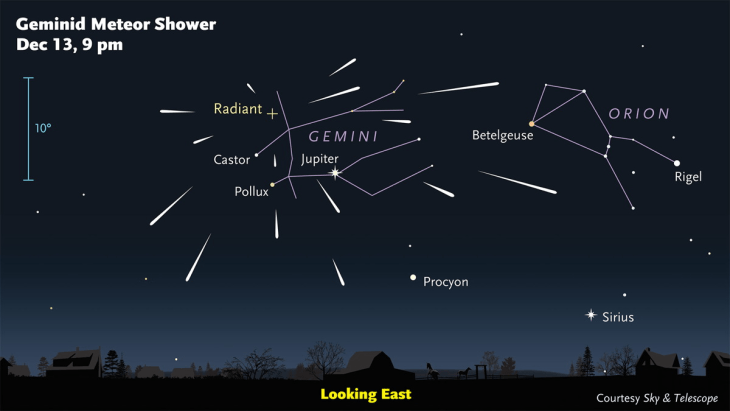by Dr. Tony Phillips.
GEMINID METEOR SHOWER--TONIGHT!
The annual Geminid meteor shower peaks tonight, Dec. 13-14, as Earth passes through a stream of gravelly debris from "rock comet" 3200 Phaethon. Dark-sky observers in both hemispheres could see as many as 120 meteors per hour during the dark hours between midnight and sunrise on Dec. 14th. Last night, Dec. 12-13, NASA's all-sky meteor network detected 15 Geminid fireballs over the USA. That number will surely grow on peak night--tonight! Got clouds? Listen for Geminid echoes in the audio feed from our live meteor radar.
......................................................................................................

Geminids meteor shower prediction: Moonless and marvelous
- Geminids meteor shower is peaking
- Geminid meteors can flash into view anywhere in the night sky
(Sky and Telescope)The nights of December 13-14 offer dark skies for a popular, underappreciated meteor display.
The
Geminid meteor shower competes with August's Perseids for showiness —
yet it's not nearly as well-known. The Geminids are easier on your sleep
schedule, too. Their radiant (near Castor in Gemini) climbs as high by
11 p.m. standard time (45 degrees above the local horizon) as the
Perseid radiant does by 2 a.m. daylight time on the peak Perseid nights.
The higher the radiant, the more meteors you'll see.
The
International Meteor Organization (IMO) predicts that the Geminids
should reach an impressive zenithal hourly rate of 120 this year. (ZHR
is how many meteors you'd see see per hour in a very dark sky if the
radiant were at the zenith. This year the peak should be centered on
roughly 18h Universal Time on December 14. Unfortunately, that's 1 p.m.
EST and 10 a.m. PST. So in North America the shower's performance is
likely to be similar on the nights of December 13-14 and 14-15.
As
the IMO notes, "Near-peak Geminid rates persist for almost a day, so
much of the world has a chance to enjoy something of the shower's best."
In addition, "mass-sorting within the stream means fainter telescopic
meteors should be most abundant almost a day ahead of the visual
maximum," and the meteors after maximum are typically brighter than
average.
The moon will be a waxing crescent a few days old, no trouble at all.
















